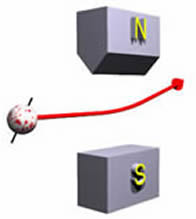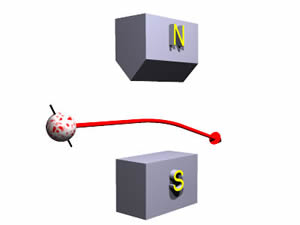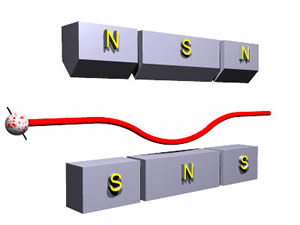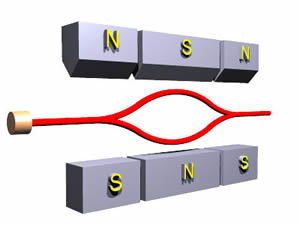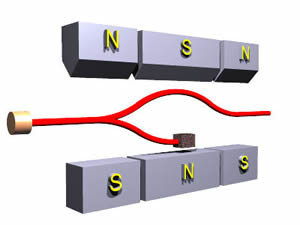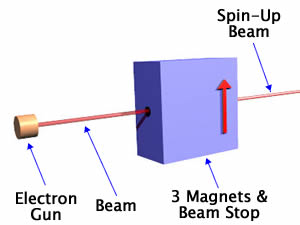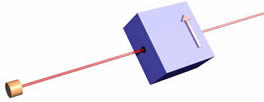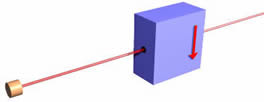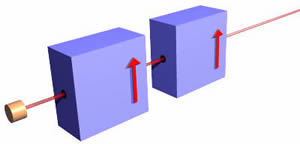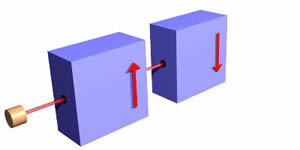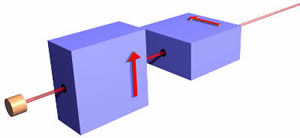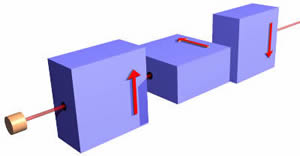The Stern-Gerlach Experiment, Electron Spin, and Correlation
Experiments
Click here to go to the
UPSCALE home page.
Click
here
to go to the Physics Virtual Bookshelf.
Introduction
This page summarises summarises the classic Stern-Gerlach experiment on
"spin" and extends the treatment to a discussion of correlation experiments. As
is often the case, I build up maximum complexity as I examine the experimental
details, and then hide them in a 'box'. This time the box will turn out to be
literal.
Here we concentrate on electrons, which have only two spin-states. We
also mention photons, which also have two spin-states. The approach is largely
based on one by Feynman which he used for objects with three spin states: see
R.P. Feynman, R.B. Leighton and M. Sands, The Feynman Lectures on
Physics, Vol III, Chapter 5 for this discussion.
Classical Charged Spinning Objects
|
We begin by considering a macroscopic charged ball that is thrown
between the poles of a magnet. If the ball is not spinning, a "knuckleball" to
a baseball fan, it will not be deflected. However, if it is spinning it will be
deflected as shown:
We ignore:
- The weird shape of the magnet pole pieces.
- The fact that there will be horizontal deflections. These can
be cancelled by putting an electric field perpendicular to the plane of the
ball's trajectory.
A Flash animation of this case has been prepared. It may be viewed by clicking here. |
|
|
For the case shown above, the figure to the right shows the spin of the charge.
We shall call this orientation "spin up" since it is deflected up
by the magnets.
|
|
The total amount of deflection is a function of
- The total amount and distribution of electric charge on the ball.
- The orientation and rate of spin. As the rate of spin increases, so does the deflection. As the axis of the spin becomes more vertical, that amount of deflection also increases.
|
|
By contrast a "spin down" electron would have its spin oriented as
shown to the left: |
|
Such an object is deflected down by the magnets. |
All of the above is just classical 19th century electricity and
magnetism.
The Spin of the Electron
|
An "electron gun" produces a beam of electrons. Further
information may be found
here.
If the beam from the electron gun is directed to the magnets, as
shown to the right, the beam is split into two parts. One half of the electrons
in the beam are deflected up, the other half were deflected down. The amount of
deflection up or down is exactly the same magnitude. Whether an individual
electron is deflected up or down appears to be random.
Stern and Gerlach did a version of this experiment in
1922. |
|
This is very mysterious. It seems that the "spin" of electrons comes in
only two states. If we assume, correctly, that the rate of spin, total charge,
and charge distribution of all electrons is the same, then evidently the
magnitude of the angle the spin axis makes with the horizontal is the
same for all electrons. For some electrons, the spin axis is what we are
calling "spin up", for others "spin down".
You should beware of the term "spin." If one uses the "classical radius
of the electron" and the known total angular momentum of the electron, it is
easy to calculate that a point on the equator of the electron is moving at
about 137 times the speed of light! Thus, although we will continue to use the
word "spin" it is really a shorthand for "intrinsic angular momentum."
Building a Spin Filter
|
As promised at the beginning, we now make the situation a bit more
complex. Consider the arrangement shown to the right:
Note that the polarity of the middle longer magnet is reversed
from the other two. We have also drawn the path of a "spin up" object. When the
object emerges from the magnets it is going the same direction as before it
entered them with the same speed.
A Flash animation of this case may be viewed by clicking here. |
|
|
The path of a "spin down" object is: |
|
|
For a beam of electrons, one-half will go follow the upper path
while and other half will follow the lower path: |
|
|
Finally, we imagine putting a small block of lead in the path of
the "spin down" electrons.
Here, one-half of the incident beam, the spin-down electrons, will
be stopped inside the apparatus, while all the spin-up electrons will emerge in
the same direction as before they entered the magnets and at the same speed.
Thus this is a "filter" that selects spin-up electrons. |
|
|
Now, again as promised, we simplify by taking all three magnets
and the beam stopper and put it in a box. In the figure we also have included
an electron gun firing a beam of electrons at the box.
So one-half of the incident beam of electrons will emerge.
It will be important to notice that we have painted an arrow on
the front side of the box to indicate what direction is "up." You can't see it
yet, but there is also an arrow pointing in the same direction on the back of
the box. |
|
Using the Spin Filter
Note that one-half of the incident beam of electrons on the filter
emerge from the box, while the other half do not. This is independent of the
orientation of the filter; in all the orientations shown below one-half of
the incident electrons emerge, while the other half do not.
Evidently the direction of "up" is defined by the orientation of the
filter doing the measurement. This is sometimes called spatial
quantisation, a term I do not like.
|
We now put a second filter behind the first with the same
orientation. The second filter has no effect. Half of the electrons from the
electron gun emerge from the first box, and all of those electrons pass
through the second filter. So, once "up" is defined by the first filter, it is
the same as the "up" defined by the second. |
|
|
Now we put the second filter behind the first and upside down
relative to the first. As always, half of the beam of electrons from the
electron gun emerge from the first filter, and none of those electrons
emerge from the second filter. So, evidently once the first filter defines "up"
that definition is the second filter's definition of "down." |
|
|
Here is another orientation for the second filter, this time
oriented at 90° relative to the first one.
To repeat once again, half of the beam of electrons from the
electron gun emerge from the first filter. It turns out that one-half of those
electrons pass through the second filter. So if we have two definitions of "up"
from two filters at right angles to each other, one half of the electrons will
satisfy both definitions. |
|
If we slowly rotate the orientation of the second filter with respect to
the first one from zero degrees to 180 degrees, the fraction of the electrons
that passed the first filter that get through the second filter goes
continuously from 100% to 0%.
Technical note: if the relative angle is A, the percentage is 100
cos2(A/2).
All of the above may remind you of polaroid filters for light. One half
of a beam of light from, say, an incandescent lamp will pass through such a
filter. If a second filter is placed behind the first one with the same
orientation, all the light from the first filter passes through the second (at
least in the case of perfect polaroid filters). A brief summary of light
polarisation appears here.
If the relative orientation of the two polaroid filters for light is
90°, then no light emerges from the second filter. This corresponds
to the case above for electron filters when the relative orientation is
180°.
If the relative orientation of the two polaroid filters for light is
45°, one half of the light from the first filter will emerge from the
second. This corresponds to the case above for electron filters when the
relative orientation is 90°.
We conclude that the only difference between electron and light filters
is a factor of 2 in the relative orientations. Thus, often we call the electron
filters "polarisers."
|
Here is a final example of combining electron filters.
One-half of the beam from the electron gun emerges from the first
polariser; one-half of those electrons emerge from the second
filter. And one-half of those electrons will make it through the
third upside-down filter! Note that if the second filter were not present, no electrons
will emerge from the upside-down filter. So we see that the middle
filter actually changes the definition of "up" for the electrons. This
is yet another manifestation of the Heisenberg Uncertainty Principle. |
|
A Flash animation of up to 3 of these Stern-Gerlach filters has been prepared.
It requires Flash 7, and has a file size of 130k. It will appear in a
separate window. To access the animation, click here.
Correlation Measurements
|
We imagine a radioactive substance that emits a pair of electrons
in each decay. These two electrons go in opposite directions, and are emitted
nearly simultaneously. When another nucleus in the sample decays, another pair
of electrons are emitted nearly simultaneously and in opposite directions. So
we can have a sample emitting these pairs of electrons. To the right we show
such a sample, enclosed in a copper colored device, and electron filters measuring the
spin of each member of the pair: |
|
For the radioactive substance we will be considering here, one-half of
the electrons incident on the right hand filter emerge and one-half do not.
Similarly, one-half of the electrons incident on the left hand filter emerge
and one-half do not.
But if we look at the correlation between these electrons, we
find that if, say, the right hand electron does pass through the filter, then
its left hand companion does not pass its filters. Similarly, if the right hand
electron does not pass through the filter, then its left hand companion always
emerges from its filter.
We say that each radioactive decay has a total spin of zero: if one
electron is spin up its companion is spin down. Of course, this is provided
that both filters have the same definition of up.
|
To the right is a case where the two filters have opposite
definitions of up.
Again, one-half of the right hand electrons pass through their
filter and one-half of the left hand electrons pass through their filter. But
this time if a particular right hand electron passes its filter, then its
companion left hand electron always passes its filter. Similarly, if the right
hand electron does not pass its filter, its companion electron doesn't pass
through its filter either. |
|
|
Now we consider yet another example.
The two filters define "up" to be in perpendicular directions to
each other. If you are still following this business with electron filters, you
will not be surprised to learn that:
- One-half of the right hand electrons emerge from their
filter.
- One-half of the left hand electrons emerge from their
filter.
- If a particular right hand electron passes its filter, one-half
of the time its companion left hand electron will emerge from its filter,
one-half of the time it will not.
|
|
|
These sorts of measurements are called correlation
experiments. We show an arbitrary relative orientation of the two
filters. |
|
We summarise all of the above by saying that when the two filters have
the same orientation, the correlation is zero: if the right hand electron
passes its companion does not. When the two filters have opposite orientations,
the correlation is 100%: if the right hand electron passes, so does its
companion, while if the right hand electron does not pass, neither does its
companion. When the two filters have perpendicular orientations, the
correlation is 50%. It turns out that the correlation goes smoothly from zero
to 100% as the relative orientation goes from 0° to 180°. For the
mathphilic student, the actual formula is that the correlation is
sin(a/2) squared, where a is the relative angle between the
filters.
There are radioactive substances that emits pairs of photons similar the
the pairs of electrons we have been consider so far. Some such substances have
similar correlations to the electron source we have been considering, except
that there is a difference of a factor of two in the relative orientations of
the polarisers. If the light polarisers have the same orientation, the
correlation is zero; this is the same as for electrons.
If the light polarisers have a relative orientation of 90°, the
correlation is 100%: if the right hand photon passes through its polariser it
companion photon will pass its polarisers, while if the right hand photon does
not pass, neither does its companion. This corresponds to the case for
electrons where the relative orientation of the filters was 180°.
Similarly, if you are still following all this, the correlation when the
relative orientation of the light polarisers is 45° is 50%, just the
correlation for electron with relative filter orientations of 90°.
As we shall see these correlation experiments, both for electrons and
photons, have been performed and turn out to give us important information
about the way the world is put together. This is the thrust of Bell's
Theorem, also sometimes known as the Einstein-Podolsky-Rosen (EPR)
paradox.
Author
This document was written by David M. Harrison, Department of Physics, University
of Toronto, mailto:harrison@physics.utoronto.ca in
March 1998. This is $Revision: 1.26 $, $Date: 2006/03/12 18:11:55 $ (y/m/d UTC).
This document is Copyright © 1998 - 2005 David M. Harrison.
